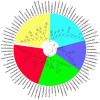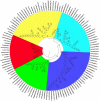Identification and Comparative Analysis of H2O2-Scavenging Enzymes (Ascorbate Peroxidase and Glutathione Peroxidase) in Selected Plants Employing Bioinformatics Approaches
- PMID: 27047498
- PMCID: PMC4802093
- DOI: 10.3389/fpls.2016.00301
Identification and Comparative Analysis of H2O2-Scavenging Enzymes (Ascorbate Peroxidase and Glutathione Peroxidase) in Selected Plants Employing Bioinformatics Approaches
Abstract
Among major reactive oxygen species (ROS), hydrogen peroxide (H2O2) exhibits dual roles in plant metabolism. Low levels of H2O2 modulate many biological/physiological processes in plants; whereas, its high level can cause damage to cell structures, having severe consequences. Thus, steady-state level of cellular H2O2 must be tightly regulated. Glutathione peroxidases (GPX) and ascorbate peroxidase (APX) are two major ROS-scavenging enzymes which catalyze the reduction of H2O2 in order to prevent potential H2O2-derived cellular damage. Employing bioinformatics approaches, this study presents a comparative evaluation of both GPX and APX in 18 different plant species, and provides valuable insights into the nature and complex regulation of these enzymes. Herein, (a) potential GPX and APX genes/proteins from 18 different plant species were identified, (b) their exon/intron organization were analyzed, (c) detailed information about their physicochemical properties were provided, (d) conserved motif signatures of GPX and APX were identified, (e) their phylogenetic trees and 3D models were constructed, (f) protein-protein interaction networks were generated, and finally (g) GPX and APX gene expression profiles were analyzed. Study outcomes enlightened GPX and APX as major H2O2-scavenging enzymes at their structural and functional levels, which could be used in future studies in the current direction.
Keywords: ROS; antioxidant; chloroplast; mitochondria; peroxisome; signal transduction.
Figures








Similar articles
-
The knockdown of chloroplastic ascorbate peroxidases reveals its regulatory role in the photosynthesis and protection under photo-oxidative stress in rice.Plant Sci. 2014 Jan;214:74-87. doi: 10.1016/j.plantsci.2013.10.001. Epub 2013 Oct 8. Plant Sci. 2014. PMID: 24268165
-
Ascorbate Peroxidase and Catalase Activities and Their Genetic Regulation in Plants Subjected to Drought and Salinity Stresses.Int J Mol Sci. 2015 Jun 12;16(6):13561-78. doi: 10.3390/ijms160613561. Int J Mol Sci. 2015. PMID: 26075872 Free PMC article. Review.
-
Novel insight into functions of ascorbate peroxidase in higher plants: More than a simple antioxidant enzyme.Redox Biol. 2023 Aug;64:102789. doi: 10.1016/j.redox.2023.102789. Epub 2023 Jun 16. Redox Biol. 2023. PMID: 37352686 Free PMC article. Review.
-
[Expression regulation of plant ascorbate peroxidase and its tolerance to abiotic stresses].Yi Chuan. 2013 Jan;35(1):45-54. doi: 10.3724/sp.j.1005.2013.00045. Yi Chuan. 2013. PMID: 23357264 Review. Chinese.
-
Identification and expression profiling analysis of ascorbate peroxidase gene family in Actinidia chinensis (Hongyang).J Plant Res. 2020 Sep;133(5):715-726. doi: 10.1007/s10265-020-01206-y. Epub 2020 Jun 6. J Plant Res. 2020. PMID: 32506283
Cited by
-
The Cotton GhWRKY91 Transcription Factor Mediates Leaf Senescence and Responses to Drought Stress in Transgenic Arabidopsis thaliana.Front Plant Sci. 2019 Oct 29;10:1352. doi: 10.3389/fpls.2019.01352. eCollection 2019. Front Plant Sci. 2019. PMID: 31736997 Free PMC article.
-
Carbohydrate Partitioning and Antioxidant Substances Synthesis Clarify the Differences Between Sugarcane Varieties on Facing Low Phosphorus Availability.Front Plant Sci. 2022 May 11;13:888432. doi: 10.3389/fpls.2022.888432. eCollection 2022. Front Plant Sci. 2022. PMID: 35646030 Free PMC article.
-
Plant Glutathione Peroxidases: Non-Heme Peroxidases with Large Functional Flexibility as a Core Component of ROS-Processing Mechanisms and Signalling.Antioxidants (Basel). 2022 Aug 21;11(8):1624. doi: 10.3390/antiox11081624. Antioxidants (Basel). 2022. PMID: 36009343 Free PMC article. Review.
-
ASCORBATE PEROXIDASE6 delays the onset of age-dependent leaf senescence.Plant Physiol. 2021 Mar 15;185(2):441-456. doi: 10.1093/plphys/kiaa031. Plant Physiol. 2021. PMID: 33580795 Free PMC article.
-
Borrelia burgdorferi infection modifies protein content in saliva of Ixodes scapularis nymphs.BMC Genomics. 2021 Mar 4;22(1):152. doi: 10.1186/s12864-021-07429-0. BMC Genomics. 2021. PMID: 33663385 Free PMC article.
References
-
- Aryal U. K., Krochko J. E., Ross A. R. (2011). Identification of phosphoproteins in Arabidopsis thaliana leaves using polyethylene glycol fractionation, immobilized metal-ion affinity chromatography, two-dimensional gel electrophoresis and mass spectrometry. J. Proteome Res. 11, 425–437. 10.1021/pr200917t - DOI - PubMed
LinkOut - more resources
Full Text Sources
Other Literature Sources
Miscellaneous

